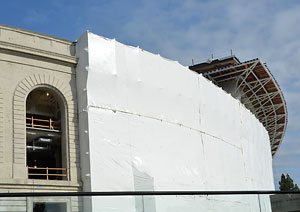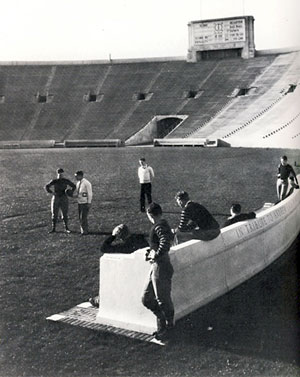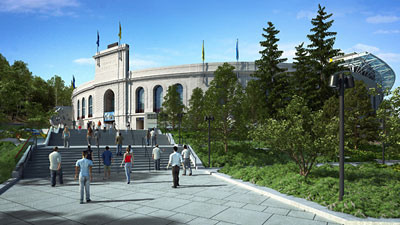Memorial Stadium suits up for Golden Bears’ kickoff
The seismic strengthening and renovation of UC Berkeley's 90-year-old football stadium is entering its final phase and on schedule to be game-ready for the Golden Bears' season opener against Nevada Sept. 1.
April 3, 2012
In less than five months, Cal football will make its long-awaited return to home turf when the Golden Bears kick off their 2012 season against Nevada at a newly restored, earthquake-safe Memorial Stadium.
Almost 18 months into the renovation of the 90-year-old stadium, which straddles the Hayward Fault, seismic-safety and modernization work is all but complete and the unprecedented $321 million redevelopment is on track to be game-ready for September’s coin toss. The team played last season’s home games at AT&T Park.
“Strawberry Canyon is a perfect setting to enjoy college football,” says Sandy Barbour, director of Intercollegiate Athletics, “and the reopening of the newly renovated Memorial Stadium will be a truly historic moment.”
The seismic portion of the project — which replaces two-thirds of the original 1923 structure, including the concourse, bowl seating, press box and other core structures, while preserving historic elements of the John Galen Howard-designed coliseum — will end with soon-to-be-completed work on the two scoreboard towers.

Almost 18 months into the $321-million redevelopment of the 1920s Memorial Stadium, the project is 80 percent complete. (Roibín Ó hÉochaidh photo)
“Priority No. 1 is getting the stadium safe, usable and permitted for everyone and we’re about 98 percent done with the retrofit, so for all intents and purposes we have a seismically safe structure,” says Bob Milano Jr., assistant athletic director and Intercollegiate Athletics’ project manager on the stadium development.
“It’s not quite usable yet and we’ll likely have some rough edges, but it would take an act of God to prevent us from staging a football game here Sept. 1,” Milano adds.
Behind the vast white curtain of protective plastic that currently envelops portions of the stadium’s exterior, major construction has given way to infrastructure, outfitting and building systems work throughout the 63,000-seat state-of-the-art stadium — the eight-level media, hospitality and operations center is scheduled to be fully enclosed by the end of April.
Mechanical, electrical and plumbing rough-in work is about 95 percent complete. The infrastructure and outfitting work, from the installation of utilities to life-safety and communications systems, from framing, glazing and cabling to accessibility enhancements like elevators and ramps, is at various stages of completion and will continue for several months.
Over the next five months, crews will continue working through a punch list of finishing tasks, painting and coating walls, ceilings and floors, tiling and outfitting restrooms and installing signage, handrails and light fixtures in a race against the clock to get the stadium ready.
Project team
Architects: HNTB; Studios Architecture
Structural engineer: Forell/Elsesser
General contractor: Webcor Builders
Project manager: UCB Capital Projects
“There’s a lot of work left to do, for sure, but the beauty of a project like this is that once you get the structure finished, you can work on all areas and levels simultaneously,” Milano says.
“What degree of completeness we’ll see come game day remains to be seen, but we’ve known from the beginning that we were on a tight timeline,” Milano says.
Inside the arena, re-installation of recycled benches on east side of the new concrete bowl is almost complete and crews will soon begin excavating the field, lowering the level by 4 feet for improved sight lines, before installing water management systems and laying the bowl’s new synthetic playing surface.

The Andy Smith bench was dedicated in 1927.
“We’ve tried to keep all the good things that fans loved about the stadium, the historic façade, the tight bowl-seating, the great viewing angles, the old energy, while improving all the things people didn’t like,” Milano says.
The restoration of important architectural elements is also moving forward. Scaffolding replaced the steel bracing used to stabilize and protect the historic façade during construction of the new concrete structure.
The work of repairing, patching and coating the arched walls of the original exterior, which now overlays the modern building structure like a decorative veneer, is about 70 percent complete.
“The goal is to have the façade look like a beautifully restored antique,” Milano says. “You’ll have some dings and chips and stains, but they’re the laugh lines and wrinkles of history.”
Another iconic element of the stadium, the carved granite bench that had graced the 50-yard line since 1927 in honor of former head coach Andy Smith, was placed in safe storage to protect it during the construction project.
On the west side of the stadium, the new design will return the arched concourse level of the historic façade, which had been filled in with offices, locker rooms and other facilities, to its original open-air state. The concourse sits atop the new 142,000-square-foot, two-story Simpson Student-Athlete High Performance Center, which stretches the length of the field below the stadium’s ground level.
Crews have begun removing the temporary protective shroud and scaffolding around stadium exteriors section by section. Site-preparation work is now underway on the new two-acre grand plaza of landscaped and tree-lined pedestrian open spaces, which will sweep down from the stadium’s north entrance to the edge of the main campus.

The new plaza will sweep down from the north entrance to create a pedestrian-friendly space for everyday use.
“If you’re accustomed to the old stadium, my sense is that you’ll be truly awestruck when you walk through those arches Sept 1,” says Brian Main, senior project manager with campus Capital Projects.
“The new arena is a much larger structure and as a fan, you’ll be hugely impressed with the modern amenities and facilities, improved access, great concessions, nice bathrooms, everything,” Main adds.
Stadium work, including interior finishing, ongoing restoration of the historic façade and landscaping and site work surrounding the arena, is scheduled to continue through the 2012 football season.
Meanwhile, says Barbour, “I don’t know that I’ve ever seen more excitement and anticipation for any project in all my years in college athletics. And now that it’s about to become a reality, Sept. 1 can’t seem to come soon enough.”
Related resources
Memorial Stadium gets renovated with help from Berkeley’s own
The restoration of Memorial Stadium
California Memorial Stadium project website